When you buy through our links, we may earn an affiliate commission.
Jetpacks, flying cars, robots, AI - sure, these are some of the cool things modern technology enables, but none of that is as exciting as a wireless guitar. (For guitarists anyway…). This level of technological advancement is also making moves in the music industry.
Using a wireless guitar system can give you complete freedom of movement while you're shredding your axe - whether you're on stage, or in the studio. No more frustrating cables! You can run around on stage or in your studio without worrying about getting tangled up - it's very liberating.
I've personally made the switch from wired to wireless, and I have to say it's one of the biggest quality-of-life improvements to my guitar setup. It's easy to underestimate how much of a difference a wireless system makes - it's a complete game changer. You can focus more on performance, without needing to put any mental energy into avoiding a trip!
There are loads of wireless guitar systems on the market, but they're not all made equally– so I've looked through the options to bring you this list of the best picks.
In general, I think the best wireless guitar system is the Shure BLX14. This has some of the best specs and pro-grade features but is still affordable enough for most guitar players.
Depending on your budget and needs, there might be a better choice in the list below, so make sure you check out the buyer's guide at the bottom of the page to help you make the right choice!
Quick Summary of the Best Wireless Guitar Systems
- Behringer Airplay Guitar AG10 (Most Affordable)
- Xvive U2 - Black (Great for Beginners)
- Line 6 Relay G30 (Professional Range, Intermediate Price)
- Boss WL-20 (Sleek, with Long Battery)
- Line 6 Relay G10SII (Best for Intermediates)
- Shure BLX14 - H10 Band (Best Value for Money)
- Sennheiser XSW-D Pedalboard Set (Great for Pedalboards)
- Shure GLXD14 (Versatile and Professional)
- Shure GLXD16+ Digital Wireless Guitar Pedal System (Seriously Professional)
- Line 6 Relay G90 (For the Headliners)
Moving From Wired to Wireless Guitar Setups
If you've come this far, you might be wondering whether a wireless guitar system is truly worth the money, and how much of an improvement it is over a wired setup.
Let me tell you, this is one of the best upgrades you can make to a guitar setup. Some people think it's a gimmick, but honestly, this is one of those guitar life hacks that is completely revolutionary, and I doubt you'll ever want to go back to a wired setup.
Wired setups can be incredibly annoying at times. In the studio, you get stuck on chairs, cables get tangled up, and it makes a bit of a mess. On stage, wired setups become even more restrictive. You have to make sure that you're not getting tangled up with other players, and you're an energetic performer you have to worry about tripping over your cables.
All of these problems are avoided by using a wireless system. You are completely free to move around, without the risk of getting your cables stuck on anything. You could literally do backflips on stage (if you have the skill).
Top 10 Best Wireless Guitar Systems Reviewed
If you're looking for some sweet guitar wireless system deals, this list has the best offers for any budget and skill level, and is arranged in price from low to high!
1. Most Affordable – Behringer Airplay Guitar AG10 – $69
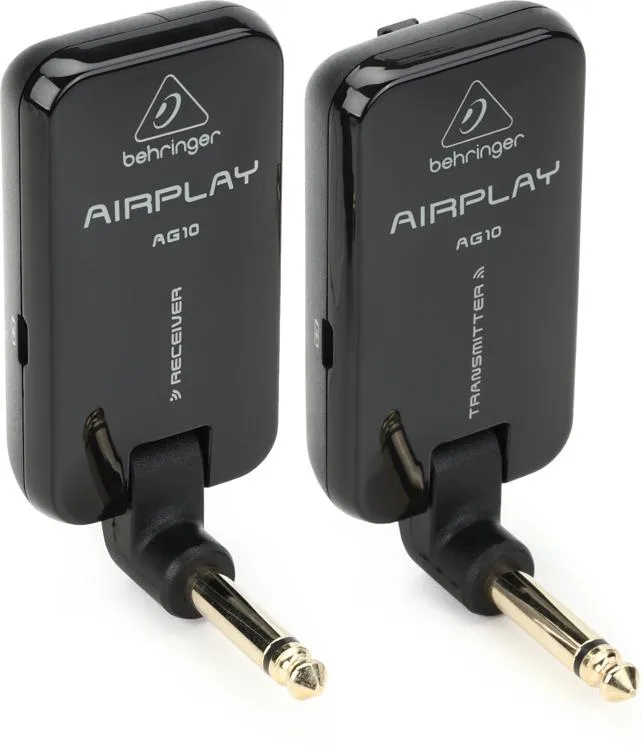
SPECS
- Latency: 5ms
- Wireless Range: 100ft
- Battery Life: 6.5 hours
- Channels: 4
Like most Behringer products, the Airplay Guitar AG10 is a low-cost, budget-friendly solution. If you’re looking to play your guitar wirelessly without spending over $100, this is a decent choice.
Sure, it has a slightly limited high-frequency response which maxes out at 16kHz, so don’t expect the most pristine tones, but it will get the job done. The signal is also on the noisier side, which will be exaggerated if you use a lot of pedals or high-gain amps. But for $69, the quality is reasonable.
Despite being super affordable, the general specs are decent, offering around 100ft (30m) of connection range, and over 6 hours of battery life with a built-in rechargeable battery. It's lightweight and has a competitively low latency of 5ms - although others on this list cut that in half.
If you’re looking for a first entry into the world of wireless guitar setups, then Behringer’s AG10 is a good first step. However, if you are looking for a more reliable system with a professional sound, you’ll need to invest in something better.
2. Great for Beginners – Xvive U2 - Black – $155

SPECS
- Latency: 6ms
- Wireless Range: ~70ft
- Battery Life: up to five hours (built-in)
- Channels: 4
The Xvive U2 is a popular and affordable choice of mid-range wireless guitar systems. This small and simple device has a decent set of specs and a tough casing that will last for years to come.
It offers full frequency range transmission (20Hz to 20kHz) meaning you can expect to hear every detail of your guitar come through the airwaves. The built-in rechargeable battery lasts for around 5 hours, which is more than enough for a gig or two in between charging.
3. Professional Range, Intermediate Price – Line 6 Relay G30 – $230
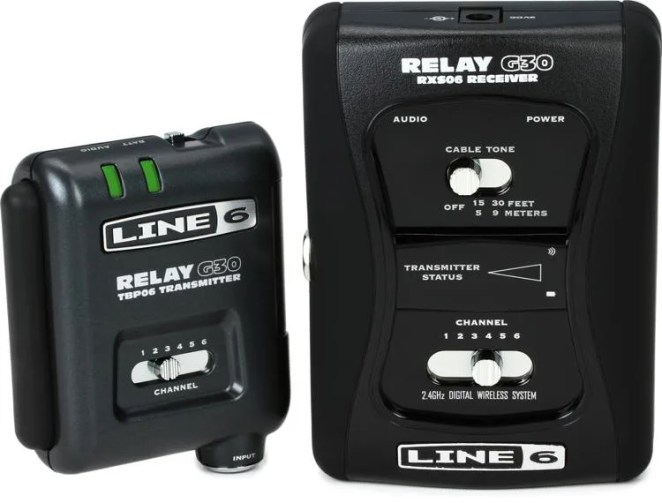
SPECS
- Latency: < 2.9ms
- Wireless Range: 100ft
- Battery Life: 8 hours on AA batteries
- Channels: 6
The G30 is Line 6’s lower entry point into their Relay series wireless guitar systems, and while being the most affordable in their lineup, it still has excellent performance.
Offering full-range frequency transmission and a reasonable 100ft (30m) connection distance, the G30 provides solid audio quality and enough room to move around most mid-sized stages.
It uses AA batteries, which is handy - because you can use two sets, having one charging while the other is in use. It has low noise and creates a clean transmission signal.
This features Line 6's proprietary Virtual Wire Transmission technology and can simulate 4 different cable lengths. This mimics the tonal effects of using a real cable, where some high frequencies are rolled off.
This will be good enough for most intermediate situations, although for larger stages and bands, an expanded setup would be needed.
4. Sleek, with Long Battery – Boss WL-20 – $230

SPECS
- Latency: 2.3ms
- Wireless Range: 50ft
- Battery Life: ~10 hours
- Channels: 14
Boss is a well-known name in the guitar and music gear industry, and the WL-20 lives up to their high reputation. In comparison to the Line 6 G30 which costs the same, the WL-20 offers more than twice the number of channels, and a larger, built-in battery, at the cost of some connection range.
The USB charging cable means you don’t need to worry about carrying around an additional battery charger. It also lasts a little longer than AA battery models. Although, you won’t be able to use it while charging.
It can be switched between 14 channels, meaning you can run a total of 14 different Boss wireless systems in the same location without interference - which is plenty for most situations. It also features cable emulation to alter the tone slightly.
5. Best for Intermediates – Line 6 Relay G10SII – $270

SPECS
- Latency: < 2.9ms
- Wireless Range: 130ft
- Battery Life: 7 hours
- Channels: 11
The G10 is a step up from Line 6’s G30 and has improved specs all around. The receiver comes with a built-in USB chargeable battery, and a 9V DC power cable, meaning you can run it off a guitar pedal chain and won't need to worry about it dying mid-performance.
The transmitter is charged by simply plugging it into the receiver, making it a nice all-in-one charging solution.
It has decent battery life and range and also features cable sim technology to switch between 10 and 30-ft guitar cable emulations.
It also features an automatic channel selector, which scans through the options and chooses the cleanest channel for transmission. This is a decent choice for users looking for a slightly more professional option on the Line 6 array, without a top-end price tag.
6. Best Value for Money – Shure BLX14 - H10 Band – $299

SPECS
- Latency: < 4ms
- Wireless Range: up to 300ft
- Battery Life: up to 14 hours (on two AA batteries)
- Channels: 12
Shure is another big name in the gear world, and their BLX14 is a powerful, pro-grade solution for guitarists looking for some wireless freedom.
This uses a slightly different setup to previous products, instead coming with a bodypack transmitter. This is clipped onto the player’s belt or clothing rather than being a unit sticking out of the guitar's jack. This has a more professional and streamlined look.
This design also means that it can easily be used with other instruments too. The system has 12 different channels, which is usually more than enough.
The receiver box is larger than the budget models, which has a nice sturdy feel and comes with a useful grouping feature for running multiple signals into the same output.
The price and quality of the Shure BLX14 make it suitable more for professionals than amateurs, and it offers excellent quality all around.
7. Great for Pedalboards – Sennheiser XSW-D Pedalboard Set – $379
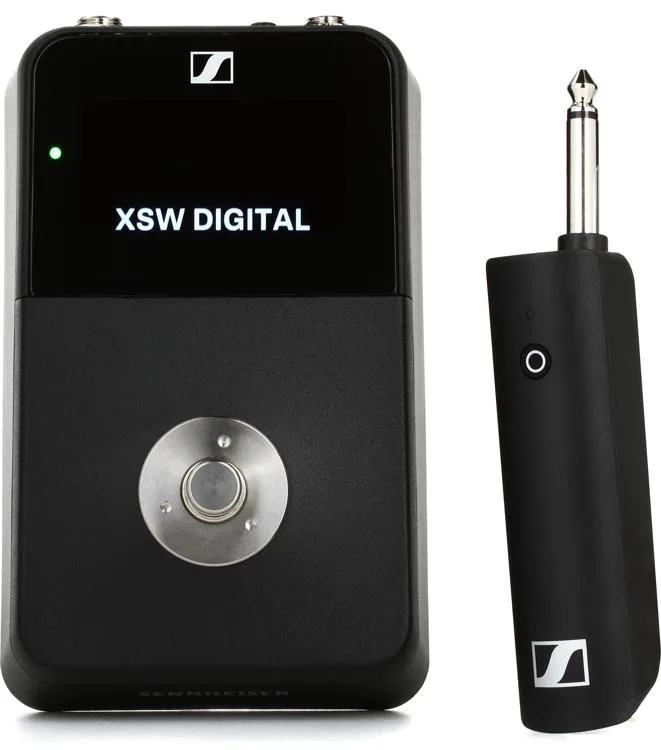
SPECS
- Latency: < 4ms
- Wireless Range: 250ft
- Battery Life: 5 hours
- Channels: 5
The Sennheiser XSW-D series provides a range of wireless audio solutions - not just for guitar. This version, however, is a specialized pedalboard system to enhance guitars with the power of wireless transmission.
This Sennheiser wireless system is super easy to use and has a remarkably large transmission range which outperforms some more expensive models. This has a bunch of cool features which makes it even more suited to the needs of a guitarist, including a built-in tuner which is a nice touch, letting you save space on your pedal board.
It’s charged through a USB-C cable and has around 5 hours of battery life, which should be enough for most situations. You also won’t need to worry about carrying around extra batteries and chargers.
The audio signal is super clean and free from interference. There are 5 other channels, and it can be used in conjunction with other Sennheiser XSW wireless products, meaning you can have a whole band setup running in tandem.
8. Versatile and Professional – Shure GLXD14 – $429
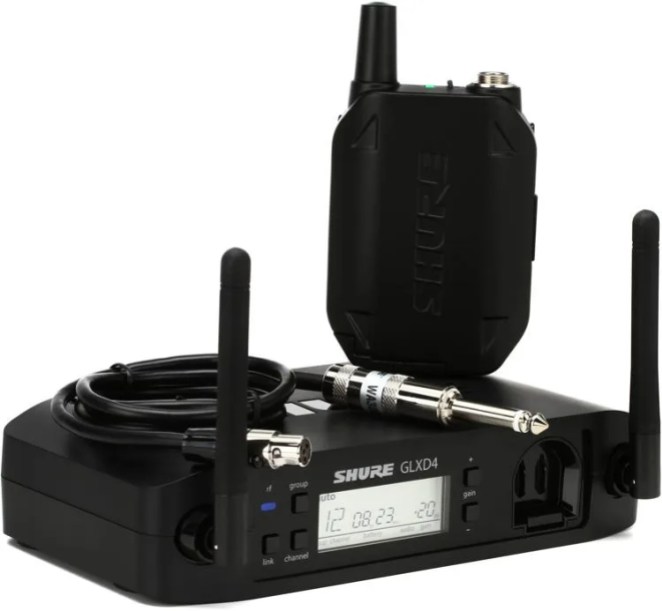
SPECS
- Latency: 4-8ms
- Wireless Range: 100ft
- Battery Life: 16 hours
- Channels: 11
The Shure GLX14 is a high-end wireless guitar solution. The battery lasts longer than most others on this list, meaning you can shred it for hours without worrying about it dying.
The transmitter and receiver are considerably chunkier and sturdier than other systems on this list, which gives it a professional look and feel. It uses a different design style to lower-cost models, instead coming as a bodypack transmitter and a thicker receiver with two antennas. This is more of a generic style, rather than specific for guitar, but it’s still a great choice for guitarists.
The receiver is powered through a wire meaning you won’t need to worry about charging it. It also has a few controls on the front panel and a nice LCD display. The display shows you the remaining battery life, which is a professional function that many engineers and performers will find incredibly useful, and takes away “battery-life anxiety".
The battery charges super fast too - 15 minutes of charging time gives around 1.5 hours of battery life!
The LINK feature lets you instantly connect the receiver and transmitter without needing to fiddle around setting them both to the same channel. It also has a channel detector setting so you can quickly find an empty one, which is useful on busy stages.
This unit has everything needed for most professional stages and studios. If you need something with a longer range, then maybe look at the GLXD16+, but otherwise this is a fantastic tool that is perfect for many professional environments.
9. Seriously Professional – Shure GLXD16+ Digital Wireless Guitar Pedal System – $499

SPECS
- Latency: 4-8ms depending on settings
- Wireless Range: 200ft
- Battery Life: 17 hours
- Channels: 11
The GLXD16+ is an ideal solution for professional guitarists in search of a wireless setup. This product is designed with guitarists in mind, which is evident from the pedal-style receiver which includes a built-in tuner, and stomp button controls.
This works on either 2.4GHz or 5.8GHz wireless bands, giving you more versatility and less interference - ensuring you can find a clean channel no matter what environment you’re working in. It also uses auto-scanning technology which constantly monitors the signal to detect interfering frequencies and automatically (and seamlessly) switches to a clean channel if problems arise.
When running in 2.4GHz mode, the GLXD16+ has the longest battery life on this list, lasting for around 17 hours of continuous operation. Surely that’s longer than any gig you’ll ever play?!
The lightweight bodypack is easily connected to any guitar, and clips onto belts and trousers without getting in the way or feeling uncomfortable. The receiver fits neatly into a pedalboard setup, meaning that this product gives you a slick, simple, and high-quality wireless guitar setup.
10. For the Headliners – Line 6 Relay G90 – $650
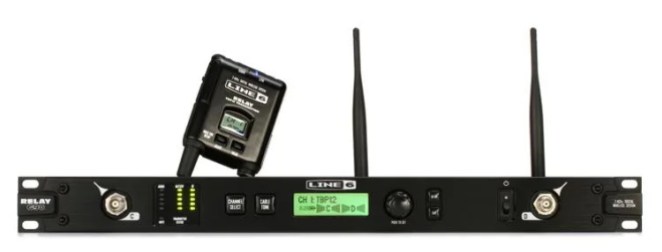
SPECS
- Latency: <2.9ms
- Wireless Range: 300ft
- Battery Life: 8 hours
- Channels: 14
If you’re looking for a professional-grade wireless guitar system, the Line 6 Relay G90 is worthy of the biggest stages and studios. This is truly a professional tool and has all the features and specs to meet the needs of headline acts and the most discerning guitar legends.
When you’re playing through a wireless setup, you want your guitar to sound and feel as if it was being played through a cable - without the tangling, of course… The G90 gives you an incredibly natural response, and it can mimic the classic sound of cables.
A notable element is the “Virtual Wire Transmission” tech and the Cable Tone Simulator. Both of these go hand-in-hand to create a realistic cable sound. When you’re a serious guitar player, you’ll notice the nuanced sound that certain types of cables create.
This cable sim option lets you pick the exact cable tone you’re looking for - giving you the familiarity of your favorite cabled setup with the freedom of a wireless rig.
This is a rack-mounted unit making it more suitable for a fully professional setup rather than a small home rig, but it has all the pro qualities needed for massive stages. Huge connection range, long battery life, minimal latency, and enough channels to fit 14 guitarists in - what more can you ask for?
Best Wireless Guitar Systems Buyer's Guide
When choosing a new wireless system for your guitar, there are a bunch of elements you need to consider to make sure you find the right style for your needs.
Typically with most of these features, the more money you spend, the better the performance. Although, you can find a lot of variation in the same price brackets.
Latency - How Responsive Is the System?
Latency is a term that describes the amount of delay experienced between playing the guitar and hearing it back through the receiver.
All digital wireless systems are prone to some amount of latency because there are several underpinning processes that enable wireless transmission, particularly the process of analog to digital conversion.
If you use a regular guitar cable, there is no latency because it's an analog system. With wireless systems, there can be a tiny delay between playing and hearing. In general, anywhere under 30ms of latency is usually not noticeable to the human ear, however, for a smoother experience, times under 10ms are more optimal.
Wireless Range - How Far Can You Move Around?
One of the main reasons people use guitar wireless systems is to extend the amount of range they have between them and their amp (and not getting tangled up on-stage). So one of the key things to think about is the range of the wireless connection.
If you're going to be performing on larger stages, then it will be worth forking out the extra cash for a longer connection range. Although, if you don't think you need loads of room, then you can go for something with a shorter range.
Ultimately it depends on the way you're going to be using it.
Battery Life and Type - How Long Can You Play?
Nothing would be more frustrating than your wireless guitar system dying in the middle of a live show - can you imagine that? For that reason, you need to make sure you pick a system with a battery life that suits your uses.
It's also worth thinking about the type of batteries used. Some have built-in rechargeable lithium-ion batteries, and others use replaceable types like AA or AAA.
If you're only practicing at home, then it's not a huge worry if it goes flat, so you can go for something with shorter battery life.
If you're using it on stage, then longer is better. Sometimes going for a model with generic batteries is the best idea for stage use because you can quickly swap them out for other batteries if they start running low.
Channels - How Many Radio Signals?
The way guitar wireless systems work means that you have access to a number of different transmission channels from the same device.
This is useful if you're running multiple members on the same type of system. Without this, there will be interference and cross-talk - which needs to be avoided at all costs.
It is important to get this right if you have multiple wireless systems running at the same time - for example, if you had a couple of guitarists on a digital wireless guitar system.
Most devices have multiple channels, but the count can vary anywhere from 2 to 10+.
The choice here ultimately depends on how many other people will be using wireless systems in your proximity. If you're playing at bigger shows or festivals, then a large channel count is essential.
Audio Quality and Frequency Response
Audio quality is obviously something that you want to maximize as much as possible, but sometimes you need to balance it with your budget.
Typically, the frequency response is the best indicator of a wireless guitar system's overall audio quality. The frequency range determines how much of the frequency spectrum is captured and transferred by wireless units. Dynamic range is also an important consideration.
The human hearing range is 20Hz-20khz, so something with a full frequency response range will offer higher quality.
Visual Style and Mounting - Does It Look Cool?
These wireless systems all come with a different visual aesthetic. This consideration is definitely secondary to function and quality, but if you're in a band that cares about looks you won't want some big ugly transmitter sticking out the front of your guitar.
(Unless you're going for that look!)
Frequently Asked Questions (FAQs)
What do pros use for wireless guitar?
Pros use a range of digital systems for wireless guitars, ultimately depending on their needs, environment, preferences, and budget.
Some of the most popular brands include Shure, Sennheiser, Line 6, and Boss, which all offer pro-grade wireless guitar systems. Larger bands tend to prefer rack-mounted receivers, which can be operated by the engineering team, rather than pedal types which the players would have to manage.
What is the difference between 2.4 GHz and 5.8 GHz for wireless guitars?
The main difference between 2.4 GHz and 5.8 GHz wireless guitar systems is the transmission frequency band that they use.
2.4 GHz systems are more common, but they are also more susceptible to interference from other devices that use the same frequency band, such as Wi-Fi routers and microwaves.
5.8 GHz systems are less susceptible to interference, but they have a shorter range and can be more expensive, and they also drain the battery quicker.
Do wireless guitar systems affect tone?
Wireless guitar systems can affect tone, but the amount of effect varies depending on the quality of the system.
Some wireless systems can introduce a noticeable amount of latency, which can make the guitar out of sync, and hard to play. Other systems can add noise or distortion to the signal.
One common complaint is that wireless setups lack the natural ‘cable tone’ created by longer cables, meaning the wireless sound can be a little bright and harsh. Although some systems include cable tone simulation to counteract this effect.
Can you play guitar wirelessly?
You can play guitar wirelessly, all you need is some kind of wireless guitar system. This has two parts: the transmitter (which is plugged into your guitar) and the receiver (which is plugged into your amplifier).
The transmitter uses a wireless signal to send the audio from the guitar to the amplifier, meaning you can run around with no cable connecting your guitar to the amp. It's like magic! Check out some of the best wireless guitar systems in the review above!
Final Verdict
With this guide, you’ll have no problem finding the perfect wireless system for your guitar. So long as you consider all the important specs like range, battery life, audio quality, and channel count, you’ll quickly be able to appreciate the joys of a wireless guitar.
Overall, the best choice is probably the Shure BLX14, as it offers great value for money, with pro features at a reasonable price. That said, the Behringer Airplay Guitar AG10 is a decent affordable option, and the Line 6 Relay G90 might be more suitable for certain professionals.
I will say, that getting a new wireless guitar system is very exciting, and makes a huge difference to the guitar-playing experience - enjoy!
